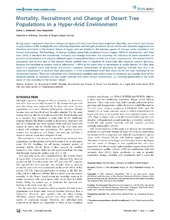| dc.description.abstract | Background: Long-term vegetation changes in hyper-arid areas have long been neglected. Mortality, recruitment and change in populations of the ecologically and culturally important and drought persistent Acacia tortilis and Balanites aegyptiaca are therefore estimated in the Eastern Desert of Egypt, and are related to the primary agents of change, water conditions and human intervention. Methodology: A change analysis using high-resolution CORONA images (1965) in combination with field data (2003) is the basis for recruitment, mortality and change estimates. For assessing the influence of water conditions on patterns in recruitment and survival, different types of generalized linear models are tested. Conclusions: The overall trend in population size in that part of the Eastern Desert studied here is negative. At some sites this negative trend is alarming, because the reduction in mature trees is substantial (>50%) at the same time as recruitment is nearly absent. At a few sites there is a positive trend and better recruitment. Frequent observations of sprouting in saplings indicate that this is an important mechanism to increase their persistence. It is the establishment itself that seems to be the main challenge in the recruitment process. There are indications that hydrological variables and surface water in particular can explain some of the observed pattern in mortality, but our results indicate that direct human intervention, i.e., charcoal production, is the main cause of tree mortality in the Eastern Desert. | en_US |
